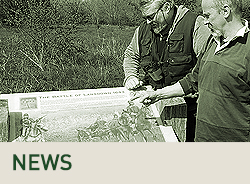Other pages about
Battle of Seacroft Moor
Battle of Seacroft Moor
30th March 1643
Name: Battle of Seacroft Moor
Date: 30 March 1643
War period: Civil Wars
Start time and duartion: afternoon lasting only a short time
Outcome: Royalist victory
Armies and losses: Royalist: 20 troops of cavalry (c.1,000 men) under George Goring; Parliamentarian: a mainly musketeer infantry force with local levies and three troops of cavalry under Sir Thomas Fairfax. Losses: up to 1,000 parliamentarians killed or captured.
Location: approximately located on the east side of Leeds in the now built up area of Seacroft and fought over unenclosed upland moor
Map details: Grid Reference: SE346360 (434649,436058); OS Landranger map: 104; OS Explorer map: 289
A royalist force attacked a parliamentarian army, which lacked sufficient cavalry support, and killed or captured most of their infantry.
Sir Thomas Fairfax had marched to Tadcaster to destroy the bridge over the river Wharfe, which controlled the main road westward. He failed and so fell back into the West Riding, pursued by a large body of royalist horse sent under the command of George Goring to intercept him. Fairfax's force was from the enclosed landscape of West Yorkshire and so was strong in musketeers. In an enclosed landscape they were a fromidable force but in an open landscape they were very vulnerable to cavalry attack. Although they managed to cross Bramham Moor safely, Fairfax's men began to straggle as they crossed Seacroft Moor, marching on the main road towards Leeds. Goring, rather than following the Parliamentary force, had moved onto Seacroft Moor via a more northerly route. Twenty troops of royalist horse descended on the smaller parliamentarian force and with only three troops of horse and few, if any, pikemen to protect his musketeers and clubmen from cavalry attack they were defeated.
Fairfax lost as many as 1000 of his infantry at Seacroft and in later years he would describe this as his worst ever defeat, with only a few cavalry reaching the safety of his father's main army at Leeds.





